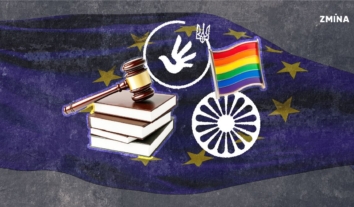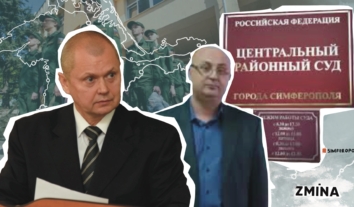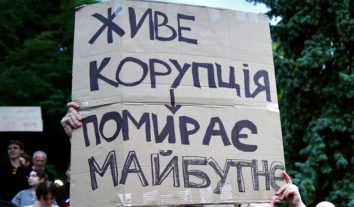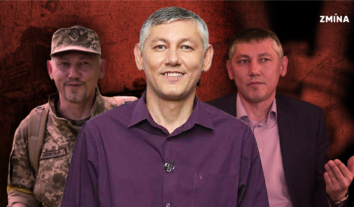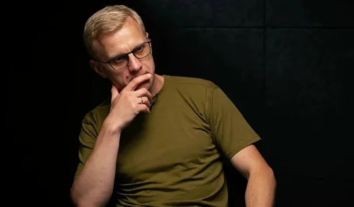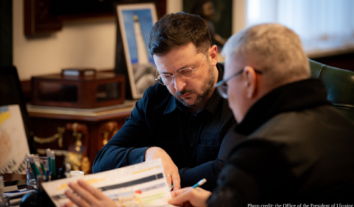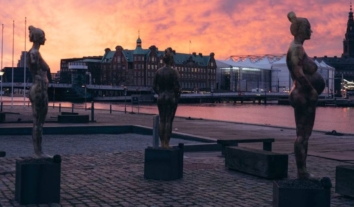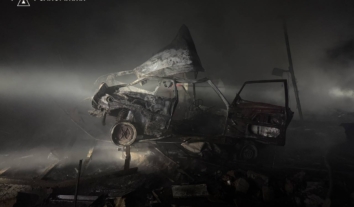Humanitarian Journalism: How to Do No Harm
Journalists, who are faced with the problems of people affected by the conflict in the East, will not resort to speculation and generalizations.
This statement was made by experts during the discussion “New Challenges to Ukrainian Journalism at the Times of Humanitarian Crisis,” which was organized by the public initiative “Crimea SOS” with the support of UNHCR and the Canada Fund for Local Initiatives.
Andriy Kulikov, a journalist and a media coach who moderated the discussion, said that the impact of this situation is felt on both sides: “We influence, we form public opinion, the opinion of the citizens. But, we also are the objects of thought, objects of actions aimed at us, including by those so-called ordinary Ukrainians with whom we meet, who we take the materials from and to whom, in the end of the day, our work is directed”.
Kulikov tells how he recently had to carry out a simultaneous translation of a briefing by the head of the State Emergency Service press office, which was about how they help the forced migrants. It was difficult to translate because the speech did not tell a single human history, only numbers.
“Until a person has touched these problems with their own hand, mind, and soul – until they feel the pain and doubt, and sometimes joy, because joy happens too in difficult times, of those people about whom we speak – until then our stories, analytics, and assumptions will not have a corresponding effect and influence on other people”, says Kulikov.
He says that sometimes it is difficult to refrain from emotion. Sometimes you wonder to what extent emotions impede your work and to what extent they help.
Sergiy Karaziy, a Reuters Ukraine video correspondent, notes that anyone could become displaced, just as anyone can be struck with a serious illness: “In my work over the last 20-25 years, I have been in many countries where there is a refugee crisis: Bosnia, Kosovo, Dagestan. I have often thought when filming and talking to these people how I would feel in their place. The scale of the world is so great that I always really wanted to believe that this will never happen in Ukraine. But, for example, in Kosovo, I spoke with refugees who were professors, very rich people who lived in the same tents as those who traded in the market. That is, I have a very clear understanding that this can happen to anyone”.
Karaziy notes that in recent years the standards of journalism have fallen dramatically. The media tries to write faster and get more “likes,” so it is necessary to return to principles like accuracy and the verification of information. According to him, for example, the increase in petty crime has nothing to do with the number of internally displaced persons, as claimed by a large number of media outlets. These two facts simply coincided in time. Karaziy gives the example of the story of how the people of Lviv were questioned on whether they would rent houses to the displaced or not. The main mistake made was that the interviewed were just people on the street, not one of them was an owner of an apartment that they could rent, nor a realtor, nor had any other relation to the rental market.
Karaziy notes that the country still has no concept of how to deal with the internally displaced. There is no answer to the question of whether or not migrants from the Donbas are a short-term problem, a temporary problem, or it is permanent. Accordingly, it is necessary to either temporarily provide them with normal living conditions within the territory still controlled by the government of Ukraine and then have them return home, or to provide them with permanent housing and employment and to recognize that the territory is lost.
Podrobnosti journalist Roman Bochkala, who was born in Crimea and moved to Kyiv in 2008, recalls visiting a town of refugees from South Ossetia near the Georgian village Natakhtari. He was amazed that these people actually stayed in a sort of ghetto: “All their thoughts are in the past and they live in conditions not very fit. Those houses they live in were built for them somewhere in the field, not temporary ones but made of bricks. I kept thinking about why all these people are settled together, these people who are united not only by the culture and language, but also their shared pain. When the pain is in each house, and the houses are close together, you feel one great pain”.
Bochkala recalls that, in conversations with fellow Crimeans who went to Lviv, there was talk about whether to build separate towns for the displaced. According to him, this should not be done in order to avoid creating a new separate Donetsk or Luhansk.
Bochkala expressed the view that the occupation of Ukraine took place where a lot of the population supported such action. Kulikov disagreed and stated that a significant number of enemy agents departed from the Kharkiv, Odessa, and Mykolaiv regions after the enemy realized that it was not succeeding in the Donbas, and that the plan cannot be implemented if their forces were evenly distributed in all of these areas. Thus, the Donbas actually saved a few other regions of Ukraine by taking upon itself most of the enemy’s resources, both human and material.
Crimea SOS Coordinator Tamila Tasheva noticed that the events in the Donbas have drawn media attention away from Crimea. To fix this situation, Crimea SOS, Human Rights Information Center, Euromaidan Crimea and other organizations are starting an information campaign “Crimea is Ukraine,” during which social network users are invited to publish their Crimean photos with the hashtag #CrimeaisUkraine. On Saturday, February 28th at noon at the Independence Square, Twitter storm participants will be able to “unvirtualize” by taking part in a rally of solidarity with Crimeans who became hostages of the occupation of the peninsula.
Natalya Gumenyuk, a Ukrainian international journalist and one of the founders of Hromadske TV, says that right before the discussion she received a call from a displaced person in Popasna, whom she met in summer when the woman was leaving Pervomaisk: “I was a bit knocked by the conversation. First of all, she spoke very calmly. I asked: what about Pervomaisk? She left a house behind there, and they have not had their documents since June so they cannot get any help. I asked whether people go now, under this permit regime, to the neighboring Pervomaisk? She calmly said, “No, you know, they do not go anymore. Not because of permits or because it is blocked. There are so many landmines that when seniors go on rails, they are often mined, and there is nothing left of them. So we stopped going”. She told me how the Red Cross was selling them humanitarian aid. She told of certain abuses, recalling how she once took a loaf of bread without papers, and found herself in a very unpleasant situation because she was not registered. This is a reminder of how far we are from that reality”.
Gumenyuk notes that it is important to bring up and discuss the problems of forced migrants. In comparison to human deaths, people being forced to leave their homes is not regarded as that terrible and we often do not notice those very complex psychological and material problems that are associated with the loss of housing.
The media often writes about certain stereotypical situations involving the displaced, even though in reality they do not happen that often, says Gumenyuk. These situations are brighter, more interesting, or more acute for journalists, but then it turns out that these situations become reflective of the overall picture. In fact, as Gumenyuk notes, discrimination against the displaced happens more frequently than cases of indecent behavior on their part. For example, Gumenyuk recalls the headline “Refugees are taking our jobs,” which she saw in September in the newspaper Segodnya . She believes it is a question of journalistic responsibilities. At the same time, those people who write in-depth materials about these issues do not allow any undue generalizations, says Gumenyuk.
Some speakers who appear on Hromadske TV sometimes make inappropriate statements, but they are not interrupted or asked why they think that way, says Gumenyuk. Much of the editorial staff is made up of the displaced from Makiivka, Horlivka and Luhansk and perhaps this situation levels out because of them.
During the discussion, the experts expressed the opinion that public figures and artists are trying to sew the country together, and journalists are the threads that help to do it. Or not. The message that all migrants are bad arises from a lack of critical thinking, and journalists and others who form the public opinion must be more careful with their messages.

